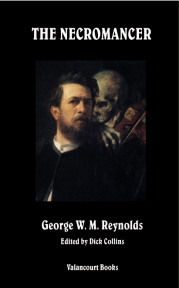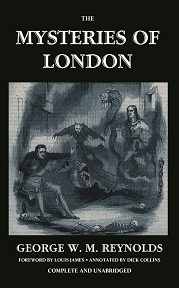GEORGE W.M. REYNOLDS
Author biography:
George W. M. Reynolds was born in 1814 in Sandwich, Kent, to wealthy parents, George and Caroline Reynolds, both of whom died by the time he was a teenager. Although his guardian enrolled him in the Royal Military College, Reynolds rebelled and left England for France with his younger brother Edward in tow. In France, Reynolds worked in a Paris bookstore, composed his first novel, The Youthful Imposter (1835), and wed Susannah Pierson at the British embassy. When Reynolds returned to England with his family in 1835, he was bankrupt. Unfortunately, this was only the beginning of Reynolds’s financial woes, for he would declare bankruptcy again in 1840 and 1848.
Reynolds was a prolific writer, publishing novels, short stories, and nonfiction articles, some of which were original, some plagiarized. Reynolds’s Pickwick Abroad (1837-38) shamelessly borrowed from Charles Dickens’s Pickwick Papers (1836-37), as did his Master Timothy’s Bookcase (1841-42), which was based on Dickens’s Master Humphrey’s Clock (1839). In 1844, Reynolds published The Mysteries of London,modeled on Les Mystères de Paris by Eugène Sue. Reynolds’s Mysteries was wildly successful, selling over a million copies within a decade. Reynolds would go on to write over twenty serialized novels, including Wagner, the Wehr-Wolf (1846-47), The Coral Island (1848-49), and The Rye House Plot (1853-54). His oeuvre included historical and gothic fiction, along with tales of adventure that frequently featured violence, gore, and licentious female characters. Reynolds’s fiction primarily targeted a lower- and middle-class readership and was enormously popular.
Reynolds was also a journalist. He worked as an editor for the Monthly Magazine before being fired for plagiarism. Later, as co-founder and editor of the London Journal, Reynolds increased circulation by featuring sensational fiction accompanied by equally sensational woodcuts; however, Reynolds soon had a falling out with the owner, George Stiff, which led him to found his own publication, Reynolds’s Miscellany, in 1846. Reynolds’s Miscellany remained in circulation until 1869 when it merged with Bow Bells. Reynolds died in 1879.
- Contributed by Alexis Easley & Shannon Scott
George W. M. Reynolds was born in 1814 in Sandwich, Kent, to wealthy parents, George and Caroline Reynolds, both of whom died by the time he was a teenager. Although his guardian enrolled him in the Royal Military College, Reynolds rebelled and left England for France with his younger brother Edward in tow. In France, Reynolds worked in a Paris bookstore, composed his first novel, The Youthful Imposter (1835), and wed Susannah Pierson at the British embassy. When Reynolds returned to England with his family in 1835, he was bankrupt. Unfortunately, this was only the beginning of Reynolds’s financial woes, for he would declare bankruptcy again in 1840 and 1848.
Reynolds was a prolific writer, publishing novels, short stories, and nonfiction articles, some of which were original, some plagiarized. Reynolds’s Pickwick Abroad (1837-38) shamelessly borrowed from Charles Dickens’s Pickwick Papers (1836-37), as did his Master Timothy’s Bookcase (1841-42), which was based on Dickens’s Master Humphrey’s Clock (1839). In 1844, Reynolds published The Mysteries of London,modeled on Les Mystères de Paris by Eugène Sue. Reynolds’s Mysteries was wildly successful, selling over a million copies within a decade. Reynolds would go on to write over twenty serialized novels, including Wagner, the Wehr-Wolf (1846-47), The Coral Island (1848-49), and The Rye House Plot (1853-54). His oeuvre included historical and gothic fiction, along with tales of adventure that frequently featured violence, gore, and licentious female characters. Reynolds’s fiction primarily targeted a lower- and middle-class readership and was enormously popular.
Reynolds was also a journalist. He worked as an editor for the Monthly Magazine before being fired for plagiarism. Later, as co-founder and editor of the London Journal, Reynolds increased circulation by featuring sensational fiction accompanied by equally sensational woodcuts; however, Reynolds soon had a falling out with the owner, George Stiff, which led him to found his own publication, Reynolds’s Miscellany, in 1846. Reynolds’s Miscellany remained in circulation until 1869 when it merged with Bow Bells. Reynolds died in 1879.
- Contributed by Alexis Easley & Shannon Scott



